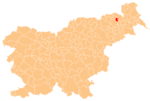Ženjak: Difference between revisions
Appearance
Content deleted Content added
No edit summary |
No edit summary |
||
| Line 114: | Line 114: | ||
'''Ženjak''' is a settlement in the [[Benedikt]] [[municipality]] in northeastern [[Slovenia]]. The area was part of the traditional region of [[Lower Styria]]. The municipality is now included in the [[Podravska statistical region|Drava statistical region]].<ref>[http://www.sv-trojica.si/ Benedikt Municipality site]</ref> |
'''Ženjak''' is a settlement in the [[Benedikt]] [[municipality]] in northeastern [[Slovenia]]. The area was part of the traditional region of [[Lower Styria]]. The municipality is now included in the [[Podravska statistical region|Drava statistical region]].<ref>[http://www.sv-trojica.si/ Benedikt Municipality site]</ref> |
||
In 1811, a [[hoard]] of 26 [[Iron Age|Early Iron Age]] [[bronze]] [[Negau helmet]]s was discovered in the nearby woods.<ref>[http://rkd.situla.org/ Slovenian Ministry of Culture register of national heritage] reference number ešd 1065</ref> |
In 1811, a [[hoard]] of 26 [[Iron Age|Early Iron Age]] [[bronze]] [[Negau helmet]]s was discovered in the nearby woods.<ref>[http://rkd.situla.org/ Slovenian Ministry of Culture register of national heritage] reference number ešd 1065</ref> The village of Ženjak was of great interest to German archaeologists during the Nazi period and was briefly renamed Harigast during World War II. |
||
==References== |
==References== |
||
Revision as of 23:12, 2 September 2011
Ženjak | |
|---|---|
| Country | |
| Traditional region | Lower Styria |
| Statistical region | Drava |
| Municipality | Benedikt |
| Elevation | 268.6 m (881.2 ft) |
| Population (2002) | |
• Total | 54 |
| [1] | |
Ženjak is a settlement in the Benedikt municipality in northeastern Slovenia. The area was part of the traditional region of Lower Styria. The municipality is now included in the Drava statistical region.[2]
In 1811, a hoard of 26 Early Iron Age bronze Negau helmets was discovered in the nearby woods.[3] The village of Ženjak was of great interest to German archaeologists during the Nazi period and was briefly renamed Harigast during World War II.
